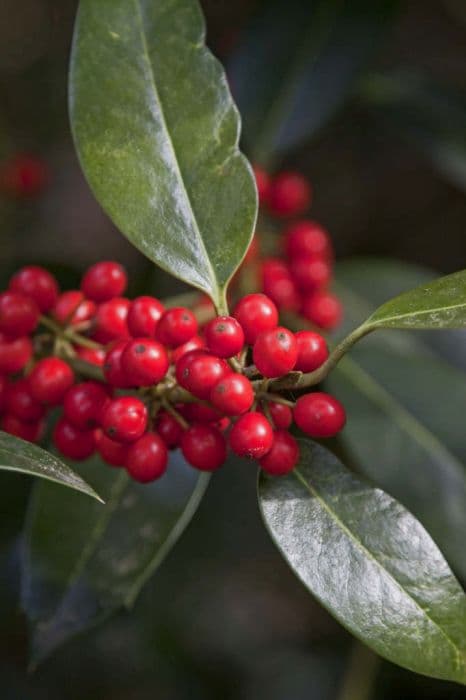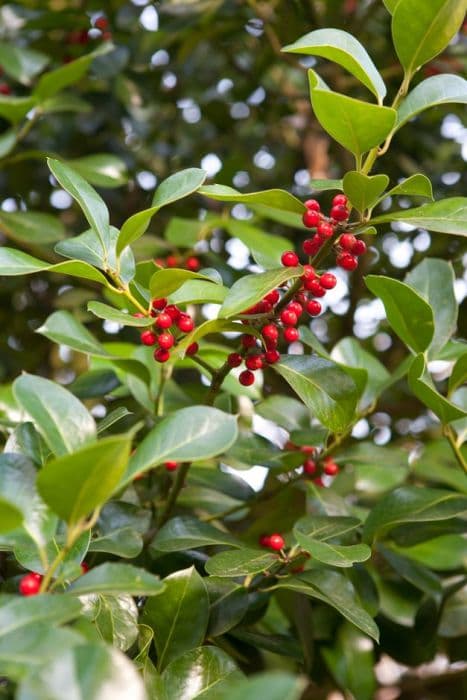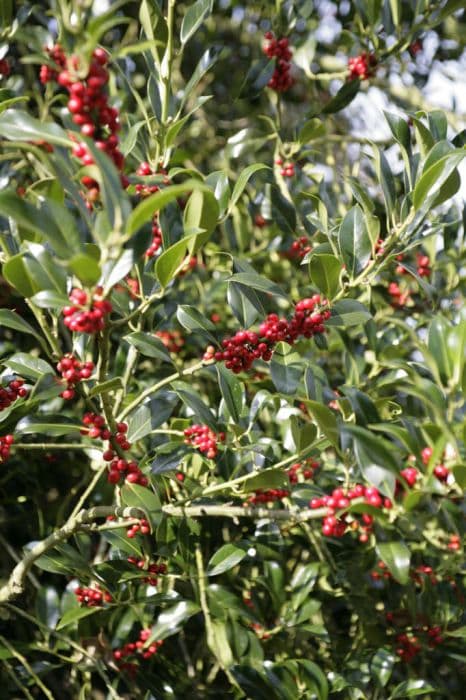Highclere Holly Ilex × altaclerensis 'Belgica Aurea' (f/v)

ABOUT
The plant commonly known as Highclere holly 'Belgica Aurea' is an attractive variety characterized by its distinctive leaves and striking coloration. The leaves are a glossy, variegated type with a combination of dark green centers and bright golden-yellow margins, giving them a vibrant, almost luminous appearance. The foliage is typically spiny-edged, as is common with many hollies, with a somewhat wavy contour that adds texture and visual interest to the plant's overall look. During the flowering period, small white blossoms may appear, which are subtle yet provide a charming contrast to the boldly colored leaves. Following the flowers, if pollination occurs with a compatible male holly nearby, the plant may produce berries. These berries are traditionally associated with hollies, offering a pop of color in the landscape, often during the colder months when other plants have ceased blooming or have lost their leaves. The growth habit of Highclere holly 'Belgica Aurea' is typically upright and dense, giving it a robust and bushy appearance. The combination of its ornamental foliage, potential seasonal berries, and its structural form makes it a popular choice for gardeners looking to add year-round interest to their outdoor spaces. This plant fits well in various landscape designs, from formal hedges to focal points in mixed borders. Overall, it is prized for its decorative attributes and its ability to bring a splash of color to gardens throughout the year.
About this plant
 Names
NamesFamily
Aquifoliaceae
Synonyms
Highclere Holly, Variegated Highclere Holly
Common names
Ilex × altaclerensis 'Belgica Aurea'
 Toxicity
ToxicityTo humans
Highclere holly, which is the most common name for Ilex × altaclerensis 'Belgica Aurea', can be toxic to humans if ingested. The plant contains saponins and other compounds that can cause symptoms of gastrointestinal upset such as nausea, vomiting, and diarrhea. Ingesting large quantities could potentially lead to more severe reactions.
To pets
Highclere holly, also known to pets as Ilex × altaclerensis 'Belgica Aurea', is toxic to pets. The plant contains saponins which can cause symptoms such as vomiting, diarrhea, and abdominal pain if ingested. In severe cases, ingesting large amounts of the plant can lead to dehydration and potentially more serious toxic effects.
 Characteristics
CharacteristicsLife cycle
Perennials
Foliage type
Evergreen
Color of leaves
Variegated
Flower color
White
Height
8-15 feet (2.4-4.6 meters)
Spread
8-15 feet (2.4-4.6 meters)
Plant type
Shrub
Hardiness zones
6-9
Native area
Cultivar
Benefits
 General Benefits
General Benefits- Ornamental Appeal: The Ilex × altaclerensis 'Belgica Aurea' is known for its attractive variegated leaves, which add color and visual interest to gardens and landscapes.
- Wildlife Habitat: This plant provides habitat and food resources for birds and other wildlife, thanks to its berries.
- Durability: It is a hardy shrub that can withstand a range of conditions, including cold climates and urban pollution, making it suitable for many environments.
- Privacy Screen: It can be used as a hedge or screen, offering privacy as it typically grows densely.
- Low Maintenance: Once established, it requires minimal care, making it a good choice for gardeners of all skill levels.
- Seasonal Interest: This evergreen shrub retains its foliage year-round, which ensures continuous garden interest even in winter.
- Soil Tolerance: It is adaptable to a variety of soil types, though it prefers well-drained conditions.
 Medical Properties
Medical PropertiesThis plant is not used for medical purposes.
 Air-purifying Qualities
Air-purifying QualitiesThis plant is not specifically known for air purifying qualities.
 Other Uses
Other Uses- Photography Prop: 'Belgica Aurea' can be used as a vibrant background or a feature in photography due to its variegated leaves which provide a natural contrast.
- Insect Habitat: Its dense foliage can offer a safe haven for beneficial insects, encouraging biodiversity in the garden.
- Privacy Screening: Due to its thick branches, 'Belgica Aurea' may be planted to create private garden areas or block the view from the outside.
- Achristmas Decor: Its branches can be trimmed and used to create festive wreaths or garlands around the holiday season.
- Nature-Inspired Art: Artists might use its unique leaf patterns and colors as inspiration for paintings, drawings, or textile designs.
- Education Tool: Botany educators may use 'Belgica Aurea' to teach about hybrid plants, variegation, and horticultural practices.
- Culinary Presentation: Although not edible, chefs can use the leaves to add a splash of color when plating dishes, making sure the leaves do not come into direct contact with food.
- Craft Materials: The leaves and stems can be used in crafting, for example, as stamps to create patterns on fabric or paper.
- Garden Sculpting: Its growth can be directed and shaped to form living sculptures or topiaries in ornamental gardens.
- Sensory Garden Component: 'Belgica Aurea' can be included in sensory gardens where its textured leaves offer visual and tactile elements.
Interesting Facts
 Feng Shui
Feng ShuiThe plant Ilex × altaclerensis 'Belgica Aurea' is not used in Feng Shui practice.
 Zodiac Sign Compitability
Zodiac Sign CompitabilityThe plant Ilex × altaclerensis 'Belgica Aurea' is not used in astrology practice.
 Plant Symbolism
Plant Symbolism- Protection: The common name for Ilex × altaclerensis 'Belgica Aurea' is "Highclere Holly." Holly plants in general are often associated with protection due to their spiky leaves, which were believed to ward off evil spirits and negative energies.
- Immortality: Holly is an evergreen plant, meaning its leaves stay green year-round. Evergreens are commonly symbols of immortality and eternal life because they do not die back in the winter.
- Fertility: With its capacity to survive harsh conditions and remain vibrant, holly can symbolize fertility and the ability to endure through challenging circumstances.
- Good Fortune: Holly's association with Christmas and the winter season has made it a symbol of good fortune and joy, as it brings color and life to otherwise dark and barren landscapes.
- Rebirth: The fact that holly remains alive and fresh in the winter has also led it to be associated with the theme of rebirth, and the perpetual cycle of life and nature.
 Water
WaterThe Highclere holly, also known as Ilex × altaclerensis 'Belgica Aurea', should be watered deeply but infrequently, ensuring that the soil has time to dry out between waterings. Generally, watering once every 7 to 10 days is adequate, depending on the weather conditions and soil drainage. Provide about 1 to 1.5 gallons of water for each watering session to ensure that the moisture reaches the deeper roots. During the hot, dry summer months, you may need to water more frequently, especially if the plant is newly established. In contrast, reduce the amount of water in the cooler months to prevent root rot.
 Light
LightHighclere holly should be planted in a location with full sun to partial shade for optimal growth. It will thrive in a spot that receives at least 4 to 6 hours of direct sunlight a day but can also tolerate light, dappled shade. Avoid deep shade locations, as this can reduce the vibrancy of the foliage and the plant's overall health.
 Temperature
TemperatureHighclere holly prefers temperate climates and can tolerate a range of temperatures. It can withstand minimum temperatures down to about 0 degrees Fahrenheit but may suffer in colder climates. The ideal temperature range for this plant is between 50 to 70 degrees Fahrenheit for vigorous growth. Highclere holly is relatively hardy and can survive brief periods of colder or warmer temperatures, but prolonged exposure to extremes can be detrimental.
 Pruning
PruningPrune Highclere holly to maintain its shape and encourage healthy growth. The best time to prune is in late winter or early spring before new growth starts. Pruning can be done annually to remove any dead, damaged, or diseased branches and to shape the plant. Light pruning to shape the holly can also be performed in summer after the plant has put on its initial growth spurt.
 Cleaning
CleaningAs needed
 Soil
SoilHighclere holly 'Belgica Aurea' prefers a soil mix consisting of well-draining loamy soil, with a slightly acidic to neutral pH of 5.5 to 7.0. Amend the native soil with organic compost to improve fertility and drainage, and consider using pine bark or peat moss to maintain acidity. This variegated holly benefits from mulching to keep roots cool and moist.
 Repotting
RepottingHighclere holly 'Belgica Aurea' generally doesn't require frequent repotting as it is a slow-growing plant. Repotting can be done every 3 to 5 years to refresh the soil or when the plant has outgrown its current pot. It is best to repot in the early spring before the growing season begins.
 Humidity & Misting
Humidity & MistingHighclere holly 'Belgica Aurea' is tolerant of average humidity levels and does not require any special humidity conditions. It can thrive in the humidity levels typically found in outdoor environments, making it quite versatile and easy to care for regarding humidity requirements.
 Suitable locations
Suitable locationsIndoor
Place in bright, indirect light and water regularly.
Outdoor
Plant in partial shade, shelter from harsh winds.
Hardiness zone
5-9 USDA
 Life cycle
Life cycleIlex × altaclerensis 'Belgica Aurea', commonly known as Highclere holly 'Belgica Aurea', begins its life as a seed, often requiring a period of cold stratification to break dormancy before germination takes place. After germination, the plant enters a vegetative stage, characterized by the growth of leaves, stems, and roots. When it reaches maturity, Highclere holly 'Belgica Aurea' develops into a bushy evergreen shrub, with variegated leaves that have a golden-yellow margin and are often spineless. This plant will also produce small, white flowers in the spring which are followed by red berries in the fall, if pollination occurs (plants are dioecious, so both male and female plants are needed for berry production). Over the years, it continues to grow in size and spread, potentially reaching up to 5 meters in height. As a slow-growing plant, Highclere holly 'Belgica Aurea' goes through these life stages gradually, with long intervals of time spent in each stage.
 Propogation
PropogationPropogation time
Spring-Early Summer
Ilex × altaclerensis 'Belgica Aurea', commonly known as the Highclere holly, is typically propagated through semi-hardwood cuttings. This method is most successful when performed in late summer. To propagate by semi-hardwood cuttings, take a 4 to 6-inch (10 to 15 cm) cutting from the current year's growth, ensuring that each cutting has at least two to three sets of leaves. Remove the leaves from the lower half of the cutting and dip the cut end in rooting hormone powder to encourage root development. Then, insert the cutting into a pot filled with a well-draining potting mix. The pot should be placed in a warm environment with indirect light and covered with a plastic bag to maintain humidity. Roots typically develop within 6 to 8 weeks, after which the new Highclere holly plants can be gradually acclimatized to outdoor conditions.









